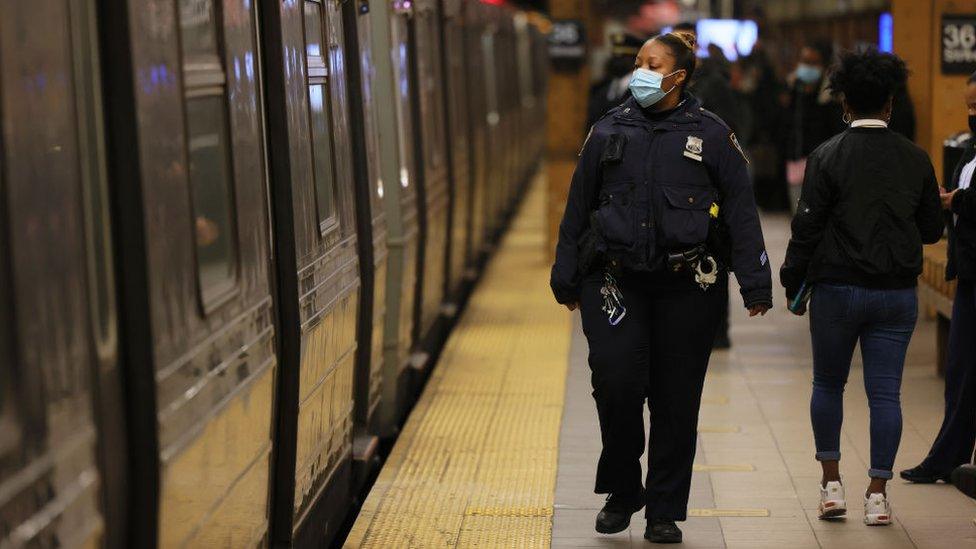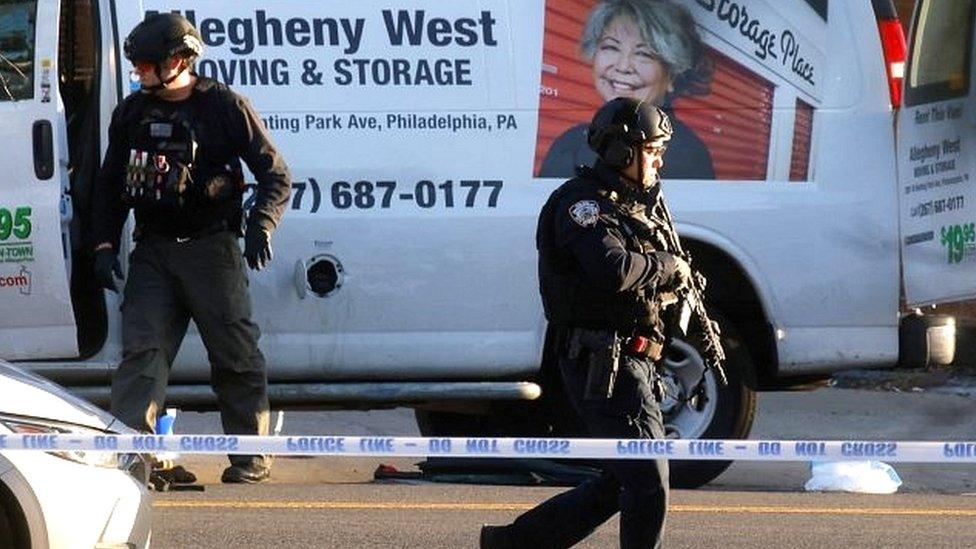Brooklyn shooting: Faulty cameras hinder NYC subway gunman hunt
- Published

A police officer patrolling the 36th street subway station after the attack
Malfunctioning cameras appear to be hindering the hunt for a gunman who shot 10 people in a rush hour attack on a New York City subway station.
Local officials for years have warned that subway cameras in the city have faced maintenance issues and chronic problems.
Police named Frank R James, 62, as a suspect, after first naming him as a person of interest after the attack.
Authorities say Mr James has posted bigoted and threatening rants online.
According to police, Mr James detonated two smoke grenades and opened fire with a semi-automatic handgun at Brooklyn's 36th Street station on Tuesday morning, striking 10 people.
Another 13 people suffered injuries as a result of falling down in the chaos, smoke inhalation or panic attacks. Mr James allegedly fled the scene.
Following the attack, New York mayor Eric Adams said that there "appeared to be some form of malfunction with the camera system".
Officials are now working to determine whether one or multiple cameras at the station were broken.
Footage shows panicked crowds on NYC subway
Citing an anonymous law enforcement official, the New York Times has reported that none of the cameras at the station was fully operational.
New York City's Metropolitan Transportation Authority (MTA) has a network of almost 10,000 cameras spread across its 472 stations, which it said this week are checked regularly.
An investigation conducted by CBS, however, says officials were repeatedly warned over the last five years that the cameras were at risk of malfunctioning.
A 2018 audit conducted by the NY state comptroller's office uncovered a chronic failure to carry out preventative maintenance on the system, with 31% of planned checks never taking place.
The same audit also found that more than a quarter of calls to the MTA's electronic maintenance division regarding camera problems took longer than three days to respond to. A follow-up conducted the next year found that "some progress" had been made.
In an interview with New York's WNYC radio on Wednesday, Adams said that the MTA is working with his office to "assist us in finding out what happened at the train station".
"We don't have a full understanding of that as of this moment," he said, adding that authorities will look at areas in which improvements can be made. "We need to learn from any issue of this magnitude".
Allow X content?
This article contains content provided by X. We ask for your permission before anything is loaded, as they may be using cookies and other technologies. You may want to read X’s cookie policy, external and privacy policy, external before accepting. To view this content choose ‘accept and continue’.
On Wednesday, police said that Mr James had become a suspect - rather than a person of interest - and did not immediately say why. The BBC has reached out to the NYPD for comment.
The motive for the attack remains unclear, although police are not treating it as an act of terrorism. Videos purporting to be from Mr James have been found online, including one in which he says he is a "victim" of Mayor Eric Adams' mental health policies.
"It's clear that this individual wanted to create terror and violence," Mr Adams said in a Wednesday morning TV appearance.
While New York City's subway system is statistically safer than in previous decades, data shows that the rate of violent crime has spiked since 2019, with the New York Times reporting that felony assaults rose by 25% over the same period.
Concerns over subway safety prompted Mr Adams to announce an "omnipresence" strategy on the subway, with hundreds of officers being deployed to stations and trains across the city.
Related topics
- Published13 April 2022
